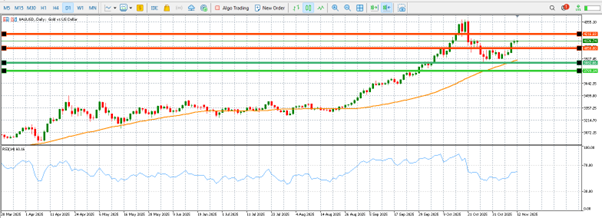Introduction
The price of gold remained strong as investors awaited the voting decision by the US House of Representatives to end the government shutdown, which will set the stage for the future economic path in the country. Most traders see the strength of gold over the past period demonstrates market interest in safety amidst market chaos, politics, and a weak US economic outlook.
The recent decision by the Senate to pass the funding bill should be seen as a sign that market sentiment will change, but markets are cautious as they want to see this deal through before investing in any assets.
In this scenario, the price strength of gold could be seen as a show of wisdom rather than a sign of market exuberance, as market participants are hedging their investments by maintaining or adding to their position in physical gold amidst growing optimism that a functional government will bring confidence to economic indicators.
We are quick to remind markets, however, that even as they show optimism through market price gains driven by policy expectations, caution should be exercised, as market uncertainty stemming from structural concerns, including economic and monetary policy, could bring market turbulence once this period passes.
Main Factors Influencing the Price
The big driver for gold prices continues to be the fresh interest in fiscal and monetary policy leadership by the U.S. The prolonged government shutdown had resulted in a lack of critical economic information, leading to a question mark over the timing of a Fed rate decision. The reopening has begun, and this should quicken the pace regarding a potential December rate cut, now seen as a 67% probability by the FedWatch tool provided by CME. A lower interest rate is often associated with reduced real yields, making other assets like gold relatively more alluring as an investment opportunity. The soft macroeconomic environment continues to offer support, with the ADP indicator indicating that an average 11,000 jobs are being shed each week by firms operating in the U.S., indicating a weak labor market, hence a dovish Fed policy posture.
As far as policies are concerned, recent developments in the Trump Administration, including the proposals regarding offshore oil drilling, shareholder voting rights, and regulation reform, have further fueled perceptions of governance uncertainty, leading investors to hedge their risks by accumulating hard assets. Globally, trends in de-dollarization, robust central bank purchases, and ETF investment continue to create structural demand. The 57% surge in gold prices so far this year represents a combination of speculative investment as well as institutional and national strategies to hedge against a diversification of currencies, as the constant pressure to accumulate this metal has established a floor price, sustaining the upward move.
Technical Analysis
Technically, gold is strongly holding an upward channel. The breach above the resistance level of US$4,050 confirmed a medium-term upwards trajectory, with the next resistance level seen between US$4,216 per ounce, A strong breakthrough past this region could open the door to a potential retest at the all-time high at US$4,381, registered on October 20. Support levels are seen around US$3,882, with a stronger anchor at US$3,789.

Gold trading chart by XTB
Momentum indicators are strongly positive, with moving averages lining up in a strong upwards configuration, emphasizing consistent institutional interest. Investors believe continued accumulation by central banks and strong purchase interest by consumers could propel gold to prices above US$5,000 an ounce by Q4 2026.
However, a tactical caution approach should be exercised by traders. Even as optimism over reopening government and dovish Fed expectations supports market sentiment, a reversal could occur suddenly if data trends change unpredictably. The next phase of the gold price move will depend, instead, on a “soft landing” situation among evidence that the pace of US economic growth slows down but doesn’t deteriorate significantly, maintaining low yields and liquid market conditions. Re-acceleration or a tightening of fiscal conditions could limit gains temporarily.
Summary
The current grinding around US $4,130 an ounce, which gold is experiencing, is representative of a market that is tempering optimism with pragmatism. While safe-haven sentiment has received a boost by the easing of the American shutdown and increasingly confident market expectations of a rate cut, investors are approaching this market with a scalpel rather than a machete.
The unpredictability inherent to politics, mixed signals emitted by economic indicators, and simmering geopolitical tensions make a structural long position in gold increasingly justifiable, particularly among institutional investors looking to diversify portfolios exposed to both stocks and the American dollar.
In our estimation at Zaye Capital Markets, gold’s simultaneous position as a hedge and as a performance asset will continue to define its leadership position through the end of Q4 2025 as unfolding patterns of shifts in policy, soft macroeconomic indicators, and structural demand continue to assert a floor price well above US $4,100 an ounce.
